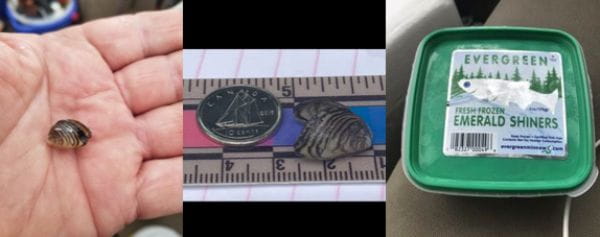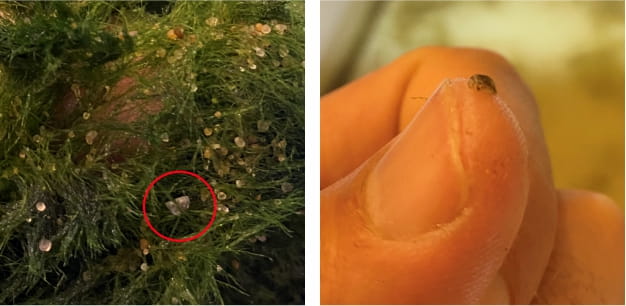June 2022 - Dead Quagga Mussel Found in Bait Sold in Saskatchewan
A quagga mussel was found in a tub of Evergreen brand emerald shiners that was purchased in Saskatchewan. The bait was harvested by a supplier in Ontario, where invasive quagga mussels are established, and was imported and sold in Saskatchewan. Fortunately, there was no risk to Saskatchewan waters, as the mussel would not have survived the freezing process. However, it's a reminder to check all bait for any aquatic invasive species – prior to use.
Anglers who have purchased Evergreen brand frozen minnows should make sure that they check their bait for any aquatic invasive species. Vendors who stock Evergreen brand frozen minnows should ensure customers are aware of the risk of contamination and remind them to inspect their bait for aquatic invasive species.
If you find evidence of invasive zebra or quagga mussels, or other prohibited aquatic invasive species, please call the 24-hour TIPP line at 1-800-667-7561 or report online.

March 2021 - Zebra Mussels Found in Moss Balls in Saskatchewan
Zebra mussels have been found in moss/algal ball products for aquariums or water gardens sold in western Canada, including in Saskatchewan, after January 1, 2021. These products are often sold as Marimo Moss Balls and are a popular ornamental plant kept with betta fish. Zebra mussels pose a serious threat to Saskatchewan waterways, so it's critical to properly dispose of any of these products you have in your possession.
The zebra mussels found on moss balls in Saskatchewan have been tiny, about the size of grain of sand, and often found inside the moss ball itself, so it's nearly impossible to detect them by a simple visual inspection. Because moss balls sold here all come from the same source, its best to be safe, assume that zebra mussels are present, and dispose of the products safely.

Proper Disposal
Follow these three steps to treat and properly dispose of moss/algal balls:
- Treat the moss/algal balls, by placing into a plastic bag, seal and freeze (preferably in a deep freezer) for at least 24 hours OR placing in boiling water for at least one minute and then let cool.
- Dispose of moss/algal balls by placing it and any of its packaging in a sealed plastic bag, and disposing of it in your household garbage.
IMPORTANT: DO NOT dispose of the moss/algal ball or any untreated aquarium/water-garden contents (e.g. substrate, plants, etc.) by flushing it down the toilet, or putting it down a drain or in a compost.
- Treat aquarium contents and water. After removing the moss balls from an aquarium, do not dispose of untreated water down the drain or into any residential water system or waterway. Instead, take these additional steps:
NOTE: Guidance for disinfecting bowls and tanks has been updated to reflect new best practices and emerging science. Anyone who has already disinfected using chlorine bleach as previously advised does not need to repeat the process.
The protocols outlined below must be followed exactly as described to be effective in decontaminating tanks and systems. Choose the method that is most practical in your situation – both, if followed correctly, will kill all zebra mussels, both adults and larvae (also called veligers).
Protocol 1: Heat treatment for tanks without plants or animals
This method provides a treatment option for tanks without plants or animals (either not present or removed), as it may harm/damage or kill other plants or animals.
- Raise the temperature of the water by using an aquarium heater or pouring in boiling water. It is important to maintain the temperature throughout the treatment to achieve 100 per cent mortality of zebra mussels.
- Ensure all tank accessories and equipment (e.g. nets) used to remove fish or other organisms/plants from the contaminated aquarium are properly decontaminated immediately after use by using the heat treatment method.
| Minimum temp. |
Minimum time |
| 40˚C |
30 min |
| 45˚C |
15 min |
| 50˚C |
5 min |
Following the thermal treatment, dispose of the water through your wastewater system.
Protocol 2: Potassium chloride (KCl) for tanks with plants or animals
This method can be used when plants and animal cannot be removed, or if Method 1 is not possible.
This treatment requires using potassium chloride (KCl), a sodium-free table salt substitute commonly sold at grocery and nutritional stores. The highest available purity of KCl available should be used. "Half-Salt" products cannot be used.
- Remove a small volume of water (approximately one litre) from your aquarium and place this water into a separate container.
- Determine the volume of water in your aquarium and the corresponding amount of KCl required to achieve the required treatment concentration using the following:
| Volume of Water in Aquarium |
Amount of KCI Required* (100% Solubility) |
| US Gallons |
Litres |
Teaspoons (US) |
Grams |
| 1 |
3.8 |
1/4 |
1 |
| 10 |
38 |
2 |
8 |
| 20 |
76 |
3 3/4 |
15 |
| 55 |
208 |
10 |
40 |
| 75 |
284 |
13 1/2 |
54 |
| 90 |
341 |
16 1/2 |
65 |
| 125 |
473 |
22 1/2 |
90 |
*Dosages outlined in this table are based on a known, lethal concentration of 100ppm KCl to invasive mussels, over an exposure period of 14 days and within the expected temperature range of home and retail aquariums (above 17°C). Measurements in this table have been rounded up for ease of measurement.
-
Add the required amount of KCl to the separate container of water and mix thoroughly.
- Pour the mixture back into your aquarium and leave it in for at least two weeks at a minimum temperature of 17°C. Water in the aquarium or system must be maintained at a minimum of 17°C for the duration of the treatment.
- Water changes should be avoided during the 14-day treatment period. If this is not possible, treat the discharge water with heat (Method 1) prior to disposal through your wastewater system.
- If removing and replacing water from the tank - To ensure consistent treatment conditions, all make-up water must be prepared using water from an uncontaminated source, warmed to a minimum of 17°C and pre-treated using KCI, based on the volume of water needed for the water change as indicated in the table provided.
- Water evaporating from the tank will not remove KCl from the system. Water (without KCl) can be added as long as the total volume of water in the tank does not exceed the initial volume when treatment began. This will ensure dosage is maintained throughout the 14 days.
- Following this 14-day treatment, water should be disposed of through your wastewater system.
NOTE: While this method is considered safe for most finfish and plants, it may not be safe for invertebrates.
Both federal and provincial regulations make it illegal to introduce an aquatic species into a body of water where it is not native. Never release aquarium pets, water garden plants, live food (fish, crabs, mollusks) or live bait into rivers, streams, lakes, ponds or storm sewers.
Anyone finding a zebra mussel, in a moss ball or anywhere else in Saskatchewan, should report it immediately to Saskatchewan's Turn In Poachers and Polluters (TIPP) line, toll-free, 1-800-667-7561.
If you have questions or concerns about zebra mussels or any other aquatic invasive species, please contact the Ministry of Environment Inquiry Centre, toll free, 1-800-567-4224, Monday to Friday, 8:30 a.m. to 4:30 p.m., or email centre.inquiry@gov.sk.ca.


